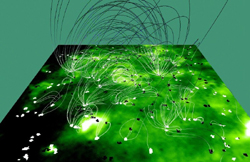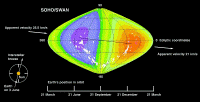Solar Atmosphere
Why the Sun's atmosphere is shockingly hot
Since 1939, when scientists first determined the temperature of the solar atmosphere - known as the corona - they were unable to come up with a convincing theory of why it greatly exceeded the 6,0000 of the visible surface.Above figure shows SOHO (ESA & NASA) MDI and EIT
Nearly 60 years later, SOHO solved the mystery. Once again the MDI acronym (short for Michelson Doppler Imager) is the code needed to decipher the secrets of our nearest star. With MDI, scientists gathered data showing that huge numbers of small, closely intertwined magnetic loops continuously emerge from the Sun's visible surface, clash with one another and dissolve within 40 hours.
The loops seem to form a tight pattern that scientists call a magnetic carpet. Their interaction generates electrical and magnetic short-circuits and releases enough energy to heat the corona to temperatures hundreds of times higher than those of the solar surface.
"We now have direct evidence for the upward transfer of magnetic energy from the Sun's surface toward the corona above," said Alan Title, who led the research at the Stanford-Lockheed Institute for Space Research, in Palo Alto, California.

Above: Alan Title, researcher at the Stanford-Lockheed Institute for Space Research
Holes in the Sun where the solar wind streams out
Like a high-tech windsock the SWAN instrument in SOHO displayed the direction and speed of hydrogen atoms streaming through the Solar System, in a chart of the whole sky. The interstellar gas glows with ultraviolet light, and the motions change the measured wavelength. SWAN also sees the hydrogen atoms disappearing because the solar wind breaks them up.Above: SOHO (ESA & NASA) SWAN
"The solar wind destroys hydrogen atoms passing close to the Sun," said Jean-Loup Bertaux of the CNRS Service d'Aironomie in France, who is in charge of SWAN. "Downwind we see distant survivors, whose speed is less affected by the Sun's gravity."


